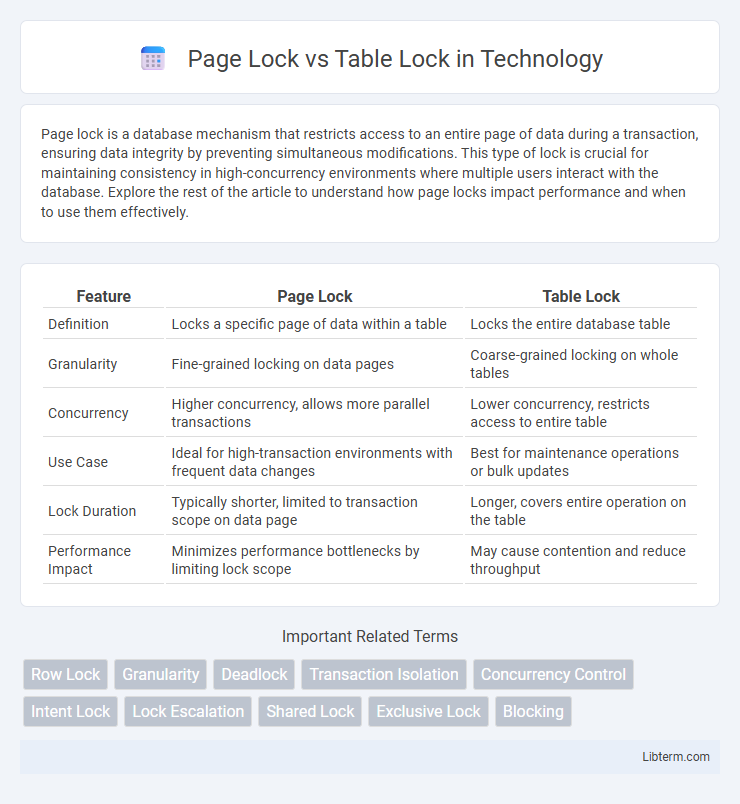Page lock is a database mechanism that restricts access to an entire page of data during a transaction, ensuring data integrity by preventing simultaneous modifications. This type of lock is crucial for maintaining consistency in high-concurrency environments where multiple users interact with the database. Explore the rest of the article to understand how page locks impact performance and when to use them effectively.
Table of Comparison
| Feature | Page Lock | Table Lock |
|---|---|---|
| Definition | Locks a specific page of data within a table | Locks the entire database table |
| Granularity | Fine-grained locking on data pages | Coarse-grained locking on whole tables |
| Concurrency | Higher concurrency, allows more parallel transactions | Lower concurrency, restricts access to entire table |
| Use Case | Ideal for high-transaction environments with frequent data changes | Best for maintenance operations or bulk updates |
| Lock Duration | Typically shorter, limited to transaction scope on data page | Longer, covers entire operation on the table |
| Performance Impact | Minimizes performance bottlenecks by limiting lock scope | May cause contention and reduce throughput |
Introduction to Database Locking Mechanisms
Database locking mechanisms control concurrent access to data, ensuring consistency and preventing conflicts. Page locks restrict access to a specific data page, allowing multiple transactions to operate on different pages simultaneously, while table locks block access to the entire table, providing a higher level of exclusivity. Efficient use of page locks improves concurrency and performance in high-transaction environments, whereas table locks simplify management but may reduce parallelism.
What Is Page Lock?
Page lock is a database concurrency control mechanism that locks a specific data page, typically 8KB in size, to manage simultaneous access and ensure data integrity. This lock type allows multiple transactions to work on different rows within the same page without interfering with each other, optimizing database performance compared to more restrictive table locks. Page locks reduce contention and improve throughput by limiting the locked scope to smaller units rather than locking entire tables.
What Is Table Lock?
Table lock is a database mechanism that prevents concurrent access to an entire table, ensuring data integrity during read or write operations. It restricts other transactions from modifying or reading the locked table until the lock is released, which can impact performance in high-concurrency environments. Table locks are commonly used in scenarios requiring bulk data modifications or maintenance tasks where consistent access to the entire table is critical.
Key Differences Between Page Lock and Table Lock
Page lock restricts access to a single database page, allowing multiple transactions to lock different pages simultaneously, which improves concurrency. Table lock, however, restricts access to the entire table, blocking other transactions from accessing any part of the table until the lock is released, which simplifies locking at the expense of concurrency. The key differences include the granularity of control, with page locks offering fine-grained access and table locks providing coarse-grained access, impacting performance and contention in multi-user environments.
Performance Impact: Page Lock vs Table Lock
Page locks improve concurrency by locking individual pages of a database, reducing contention and enabling higher transaction throughput compared to table locks, which lock entire tables and can cause significant blocking in multi-user environments. Table locks, while simpler to manage, often degrade performance in high-transaction systems due to increased wait times and decreased parallelism. Efficient use of page locking is crucial for optimizing performance in systems with frequent read and write operations.
Concurrency Control in Page Lock and Table Lock
Page lock granularity allows multiple transactions to access different pages of the same table concurrently, reducing contention and improving system throughput by isolating locks to specific data segments. Table lock enforces exclusive access to the entire table, limiting concurrency and increasing wait times, but simplifies lock management and ensures data integrity in highly transactional environments. Efficient concurrency control balances lock scope and transaction isolation to maximize performance while preventing deadlocks in database systems.
Use Cases: When to Use Page Lock
Page locks are ideal in transactional environments with moderate concurrency, where multiple users access different rows within the same data page, allowing simultaneous read and write operations with minimal blocking. Use page locks when updates or queries affect a localized subset of data, optimizing performance by reducing lock contention compared to table locks. In scenarios involving batch updates or index maintenance targeting specific pages, page locking ensures granular control and maintains higher system throughput.
Use Cases: When to Use Table Lock
Table locks are ideal in scenarios requiring extensive bulk operations, such as full-table updates or batch inserts, where minimizing overhead from multiple page-level locks enhances performance. They ensure data consistency during administrative tasks like schema changes, preventing concurrent modifications that could cause conflicts. Use table locks when the operation impacts most or all rows, and when transaction duration is short, reducing the risk of contention and deadlocks.
Pros and Cons of Page Lock vs Table Lock
Page locks enhance concurrency by allowing multiple transactions to lock different pages within the same table, reducing contention and improving performance in high-transaction environments. However, page locks can increase overhead and complexity, potentially leading to deadlocks when multiple pages are locked simultaneously. Table locks simplify transaction management by locking the entire table, minimizing deadlock chances, but they reduce concurrency and can cause significant delays in multi-user systems.
Best Practices for Choosing the Right Locking Strategy
Choosing between page locks and table locks depends on workload characteristics and concurrency requirements. Page locks offer finer granularity, improving concurrent access in high-transaction environments by locking smaller data segments, while table locks simplify management but risk contention in multi-user scenarios. Best practices include analyzing transaction size, frequency, and contention patterns to select the locking strategy that balances performance and consistency effectively.
Page Lock Infographic

 libterm.com
libterm.com